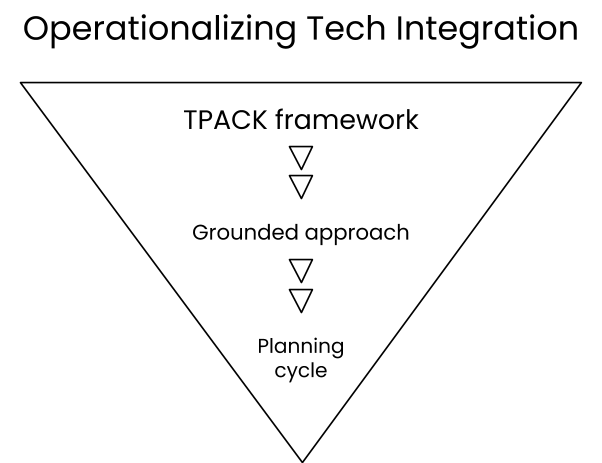Here is how I see the articulation among the following three knowledge constructs we delved into this week in the Seminar in Digital Literacy (Graduate Certificate in Digital Literacy, URI). TPACK (Koehler & Mishra, 2008) is the framework, the larger knowledge construct that undergirds the Grounded Approach to Technology Integration (Harris & Hofer, 2009), which is further operationalized into the Technology Integration Planning Cycle (Hutchinson & Woodward, 2014).
What TPACK does brilliantly is capture the complexity of the knowledge of good teachers (Shulman, 1986). It identifies the knowledge components (pedagogical, technological, and content knowledge) but it goes beyond; it explores the intersections among them, which is where good teaching practices are situated. However, TPACK is a theoretical framework which does not serve teachers in planning their instruction. We therefore need to articulate an approach to technology integration, more specifically one that is grounded in content, pedagogy, and how teachers plan instruction (Harris & Hofer, 2009). It proposes five basic steps to planning instruction:
- Choose learning goals
- Make pedagogical decisions
- Select activity types to combine
- Select assessment strategies
- Select tools/resources
What I found most useful in this approach is the continua of eight pedagogical decisions that teachers need to make to plan a learning event. They are captured in the following questions:
- Will the learning experience be more teacher centered or more student centered?
- Should students develop similar understandings (via convergent learning) or draw their own conclusions (via divergent learning)? Should the learning be more hands-on or more abstract?
- Are students’ prior knowledge and experiences less relevant or more relevant for the learning to unfold?
- Do the curriculum standards defined for the learning event require surface comprehension or deep knowledge construction?
- How much time will be needed relative to the depth of understanding (4) required? Will it require a shorter duration or a longer duration plan for learning, in and out of the classroom?
- Considering all of the above, plus students’ specific and general strengths and challenges relative to the planned activity, is more or less structured learning more appropriate?
- What should be the learner configuration(s) to best assist learning in the context the learning event will occur? Will whole-group, small-group, pairwork, individual configs work best for the learning event?
- Are fewer, more or no additional resources needed for students to participate in the learning experience? This hinges on step 5, the selection of tools/resources.
Hutchinson & Woodward’s planning cycle (2014) complements and expands on the grounded approach by zooming into a couple of important aspects: how digital tools contribute to the instruction and to the development of digital literacy skills. The authors give teachers permission to opt out of digital tool adoption should they discover, upon reflection, that “using a digital tool will not make a strong contribution to their instruction or if they are unable to locate a tool that will appropriately support their learning goal.” (p.458) Furthermore, they propose that teachers take the classroom environment and routines into consideration when considering the constraints of the tools selected for the learning event. Most importantly their cycle “(…) is specifically aimed at helping literacy teachers consider whether their planned instruction contributes to both digital and nondigital literacy development.” (p.458)


